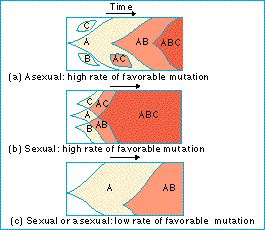Adaptations in sexual reproduction - Why do organisms reproduce sexually?

Fisher's argument for faster evolution
R.A. Fisher argued that sexual populations have a more rapid rate of evolution than would an otherwise equivalent group of asexual organisms.
Fisher's conclusion depends on the rate of mutation. If favorable mutations are rare, each one will have been fixed in the population before the next one arises. New favorable mutations will always arise in individuals that already carry the previous favorable mutation. Sexual and asexual populations then evolve at the same rate.
However, if favorable mutations arise more frequently, Fisher's argument works: the sexual population evolves faster. Each new favorable mutation will usually arise in an individual that does not already possess other favorable mutations; the greater speed with which the different favorable mutations combine together causes the sexual population to evolve faster. The higher the rate at which favorable mutations are arising, the greater the evolutionary rate of a sexual relative to an asexual population.
This is a case of group selection because it claims that the cost of sex is more than made up for by the faster evolution of the sexual population, or group.
Figure: evolution in (a) asexual and (b) sexual populations. In the asexual population, an AB individual can only arise if the B mutation arises in an individual that already has an A mutation. In the sexual population, the AB individual can be formed by breeding of a B mutation-bearing individual with an A bearing individual; the second mutation B is not needed. (c) If favorable mutations are rare, each will have been fixed before the next arises, and sexual populations do not evolve faster.
| Next |



